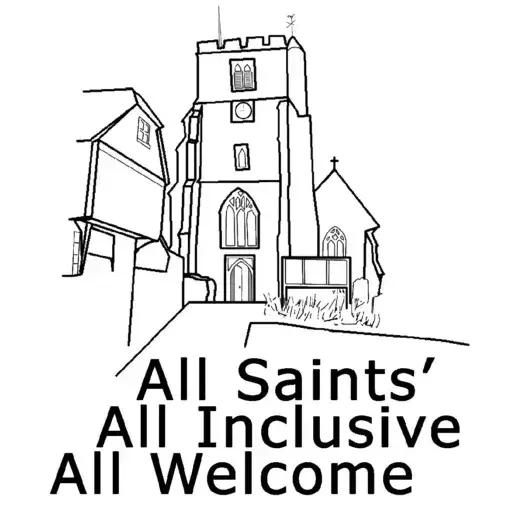All Saints Staplehurst Church Tour
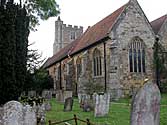
Welcome to the All Saints Staplehurst Church Tour
All Saints’ Church Staplehurst, stands on the top of the hill in the centre of the village. All Saints Church is often referred to as the “Church on the hill”.
The church was built around 1100 serving the farms which evolved from dens or pasture land used by herdsmen from the area around Maidstone. It is older than the village.
The name Staplehurst was first recorded in 1226, although specific dens such as Spilsill and Aydhurst are mentioned in Anglo-Saxon charters.
The Church
If you wish to visit All Saints’ Staplehurst, please park in the public car park on Bell Lane.
Bell Lane car park is on the opposite side of the road with the Kings Head public house nearby. Please do not park in the Kings Head public house car park.
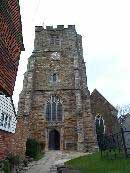
The main entrance to the Church is accessed from the road (the A229) by a short path. This path bears round to the right to access the graveyard. Ahead you will see the West door to the tower.

The Tower
Construction of the West Tower started between 1400 and 1425. It has a stairway turret and a fine perpendicular doorway. The two coronetted heads on either side of the door probably depict King Henry V and his Queen, or Lord and Lady Bourchier who died in 1432, possessed of the manors of Maplehurst and Exhurst.
Construction of the West Tower started between 1400 and 1425. It has a stairway turret and a fine perpendicular doorway. The two coronetted heads on either side of the door probably depict King Henry V and his Queen, or Lord and Lady Bourchier who died in 1432, possessed of the manors of Maplehurst and Exhurst.
The centre coat of arms, a lion rampant, is either his or that of John de Somery from Bly Court, in Chapel Lane. On the north spandrel is a coat of arms very like that of the Roberds family. On the south spandrel is an engrailed cross, the arms of the Haute family. The Tower once had an eighteenth century gallery at first floor level, now the Rector’s Vestry. The vestry accessed by a stairway from the West porch houses the board announcing Fees and Charities of the Parish, set up about 1880, which hangs opposite the Royal Coat of Arms of George III which was painted for the gallery in 1764 and rediscovered in an oasthouse at Chittenden Farm in 1951.
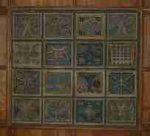
Set in the tower ceiling are 16 richly-coloured and carved Tudor panels which were removed from above “one of the dormer windows” of the south aisle. Four of the panels depict shears, a reminder of the wool trade in the area. Another bears staples and another a tree (hurst) a rebus on the name of Staplehurst. The tree carries a pomegranate and an English rose, a reference to Catherine of Aragon and Henry VIII. They must have been made in the period of their marriage – 1509 to 1533.

The Church Clock
The Clock was made in 1888 by Messrs Thwaites and Reed of Croydon. It is a very fine single-faced turret clock with gravity displacement. Owing to the confined space available, the bed of the clock was made flat and is 2 ½ metres long. It strikes the quarters and hours on five bells. The clock face is of slate which was re gilded in 1974. The Churchwarden’s Accounts mention an earlier clock – in 1665 they “Pd for borde for the clockcasse 5s”, and in 1668 “Payd John Punnet for scoweringe the cloke & mendinge him 3s”.

The Bells
Staplehurst Bells are a ring of ten. With the exception of the new treble and the 2, the only one not cast in 1885 is the Ninth, which is inscribed, “Henry Turner C. W. William Wolles C. W. 1605 Joseph Hatch made me”. Joseph Hatch was a well-known bellfounder from Ulcome. The bells seem to have been acquired piecemeal since the four bells replaced in 1885 were cast in 1594, 1649, 1663 and 1748. In 1996 the wooden frame was replaced with a steel one and two further bells added as the No.1 (or treble) and No. 2. Both cast in memory of Brian C Mitchell with the 2nd also dedicated to the village.
- 10 bells
- Tenor 19-2-7 in Eb (994 Kg) Bell Weights & Inscriptions
- Frame & Retuning: 1996 Whitechapel
- Upstairs Ringing Room
- Postcode: TN12 0AX
- Grid Ref: TQ786429
- For Sat Nav:
Lat: 51:09:29N (51.15808)
Lon: 00:33:10E (00.55266)
The eastern arch is a later attempt to span the gap where the south tower with its low doorway once stood in the aisle roof can be seen the half-kingpost which was attached to the tower west wall: the only remnant of this tower is the wide pier between chancel and chapel.
The aisle roof is of tiebeam and kingpost construction, dating from the fourteenth century. The middle window of the south aisle has delicate inner columns detached from the hood and of an earlier period. There are moulded bases and little bell capitals carved from Purbeck marble. By the south door is a fifteenth-century water stoup while the arch in the width of the south wall may be a sacred heart sepulchre. The only fragments of Medieval glass to survive 1559, when Elizabeth I ordered all painted glass to be destroyed, are mounted in a small panel on the window ledge by the south door.

The South Door
The South Door is the church’s best known historical feature. It has been authoritatively dated to 1050, which means that it displays some of the oldest ironwork in England still in situ.
It tells the story of Ragnorok, the Norse Day of Judgement, which starts with a cockerel crowing and waking Heimdall, the watchman, who blows his horn Gjallir to call the gods to battle. Nature is in confusion and the seals rush on to the land. Jormungandr, the Midgard Serpent (who has grown until he encircles the world) and other monsters on the Ship of the Dead fight the gods. The serpent is shown wriggling, and again, stretched in death, vanquished by Thor. Surt, the sunwheel, throws sheets of flame over the earth. The stars fall, while above flies Nithhoggr, who feeds on the slain. But above him is a cross, symbol of a new hope coming and a Christian conclusion to the Norse legend.
Very similar ironwork on the church door at Stillingfleet in Yorkshire continues the story with figures of a man and a woman, the only survivors of the end of the world, who hid in the ash tree Yggdrasil. Presumably, the ironwork was once distributed evenly over the face of the door, not clustered at the top as it is now.
It was designed for a round-arched door and we are not sure that it was made for this church: but wherever it was made, such skilled smithing must have needed patronage. The timber of the door was seasoned before use; the oak is cut to show the flower in the wood; and the carpentry is identical to that on other known Anglo-Saxon church doors, described by Cecil Hewett, at Greensted in Essex and Sompting in Sussex. In a region supposedly desolate in 1050, it is surprising and interesting that this quality is here.

The Hoare Monument
The Hoare family monument on the South wall once stood above the family pew. Now it is flanked by two modern stained glass windows, made by a Staplehurst firm.
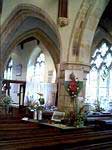
The Chancel
The Nave and Chancel were originally on the same level throughout. The east window, although restored, keeps its Decorated tracery. The glass is Victorian and a drawing near the pulpit gives details of the figures. It is a memorial to Henry Hoare and the Lady Mary his wife, given by their twelve children. It faces the monument to Marianne Stammers by the West door, who served the family for eighty years.
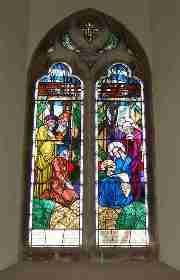
The Windows of the North Wall
On the north wall of the Chancel, two early fourteenth-century windows have identical tracery in two and one-light versions. The window by the pulpit was blocked up for many years – its flatter arch shows it to be late perpendicular. The thirteenth-century arcade has been rebuilt to parallel the fifteenth-century south wall of the chapel and not the twelfth-century chancel wall, so the east window is no longer centrally placed. As a sixteenth-century source mentions a wall on the Chancel’s south side, the arcade may have been imported in the seventeenth century.

The Organ
The organ is a Father Willis of 1896 which replaced one installed in the nave by the Rev. Thomas Crick. Father Willis organs, known today as Henry Willis & Sons Ltd, is one of the oldest and most famous organ building companies active in the world today, having been in continuous operation since 1845. Visit their website here.
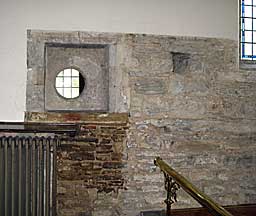
The Anchorite’s Cell
The Anchorite’s Cell communicated with the church through the round opening in the north wall. The door of the cell was blocked up so that he or she depended for every necessity on the alms left on the ledge in the church. The floor of the cell was excavated in 1936 and can be seen outside.


The Chapel
The Chapel was built in the fifteenth century and was once known as the Spilsill Chapel; belonging to the family of that name. It may also be the Chancel of the Blessed Virgin Mary alluded to in the will of Elisa Somery (the family from Ely Court) who died in 1464, directing that she should be buried near the bones of her husband Robert. The private door has its own holy water stoup. The altar tomb in Bethersden marble is that of ‘Walter Mayney of Spilsill and was originally placed where the altar now is. Walter and his two wives were portrayed in brass on top of the tomb – unfortunately only one brass now remains. After the First World War the chapel was redecorated and renamed St. George’s Chapel and became the village War Memorial. In 1966 the stonework was uncovered and the chapel beautified.


Fonts
Two Fonts can be seen; the original, battered by time was placed below the pulpit after being rediscovered as a feeding trough on a local farm. (Arthur Mee has a touching story of it being identified by a blind woman). It is carved from a single block of very hard Kentish ragstone, unlike any other used in the church. It may originally have been placed in a recess as the back is not carefully shaped and the carving stops at the half-way line. It was replaced by a new font in 1815 which stood by the south door. During the re-ordering of 1995, this new font was moved to the west porch and the original placed in its present position by the wide pier between the chancel and the chapel.
Registers
The Registers are complete back to 1538 Queen Elizabeth I proclaimed in 1597 that all registers should be copied on to parchment and the paper ones returned to the Crown upon pain of general beheading: ours is one of seven Kentish Registers still extant on paper. It contains prayers for departed souls which were left out of the 1597 copy as well as neighbourly gossip such as: “1549. The xixte day of November. There was buried Agnes, a poor woman and a stranger, whose husbande brake his neck in London, as she reported”.
There are instances of the Christian name “Creature” given to children not expected to live and therefore baptised by the midwife: “1547. The xxviith of Apryle. There were borne ii children of Alexander Beerye the one christened at home and so deceased, called Creature the other christened at churche called Johan”. (At least two Creatures grew up to be married).
In Queen Mary’s reign, between June 1556 and March 1558/9, the godparents’ names are given, as ordered by Cardinal Pole. This ceases early in Queen Elizabeth’s reign. Richard Besely, a chaplain to Henry VIII, and Rector from 1535 to 1554 and 1558 to 1585 (he was deprived of the living in Mary’s reign because he was a married clerk) took great pleasure in recording his marriage in the Register He espoused Jane Lenarde, in his own words, “orphan, spinster, dowerless, modest and honest”. The marriage took place in Lent, on March 27, 1548, before the Bill legalising the Act of Convocation allowing clergymen to marry had been passed by Parliament.
Besely also anticipated by celebrating Holy Communion in English, with guests, the bride and groom partaking, one week before the Bishops authorised it. On the same day that the new Prayer Book in English was authorised to be used in churches, June 9 1549, he baptised his three-day-old daughter Marie: “the parsone christinied his owne childe”. To a congregation accustomed to a celibate priesthood, this was astounding.
To boost the failing cloth industry a law was passed stating that everyone should be buried in a woollen shroud, and relatives had to produce a certificate to prove it. The Register of Burials in Woollen, which runs from 1679 to 1744, contains lists of “poore persons” among whom the £5 fine for those rich enough to be buried in linen was shared, ’50 shillings to the poore and 50 shillings pd to the informer’. On March 6 1690/1 the entry is, “Buried Mary ye wife of John Usborn, an affidavit of wch was brought in due time”, all as usual. But on the next page is “a true account of the monies distributed to the poor… on ye account of Mary Usborn’s buriall in Linnen…. Martin Collier informer”. He is the only one named in all the 65 years the book covers.
Staplehurst Genealogy and Local History from Rootsweb.com
Download our Brief History Document
Legend
1 – Spandrel – The roughly triangular wall space between two adjacent arches.
2 – Engrailed – Heraldry Indented along the edge with small curves.
3 – Rebus – representation of a word or syllable by a picture of an object the name of which resembles in sound the represented word or syllable..or syllable by a picture of an object the name of which resembles in sound the represented word or syllable.
